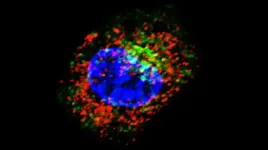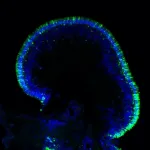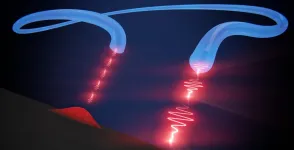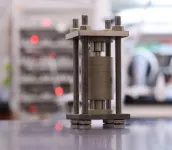Harnessing the power of AI to understand warm dense matter
CASUS researchers develop effective tool to describe exotic state of matter
2021-01-28
(Press-News.org) The study of warm dense matter helps us understand what is going on inside giant planets, brown dwarfs, and neutron stars. However, this state of matter, which exhibits properties of both solids and plasmas, does not occur naturally on Earth. It can be produced artificially in the lab using large X-ray experiments, albeit only at a small scale and for short periods of time. Theoretical and numerical models are essential to evaluate these experiments, which are impossible to interpret without formulas, algorithms, and simulations. Scientists at the Center for Advanced Systems Understanding (CASUS) at the Helmholtz-Zentrum Dresden-Rossendorf (HZDR) have now developed a method to evaluate such experiments more effectively and faster than before.
Describing the exotic state of warm dense matter poses an extraordinary challenge to researchers. For one, common models of plasma physics cannot handle the high densities that are prevalent in this state. And for another, even models for condensed matter are no longer effective under the immense energies it entails. A team around Dr. Tobias Dornheim, Dr. Attila Cangi, Kushal Ramakrishna, and Maximilian Böhme from CASUS in Görlitz are working on modeling such complex systems. Initial results were recently published in the journal Physical Review Letters. The team joined forces with Dr. Jan Vorberger from the Institute of Radiation Physics at HZDR and Prof. Shigenori Tanaka from Kobe University in Japan to develop a new method to calculate the properties of warm dense matter more efficiently and faster.
"With our algorithm, we can perform highly accurate calculations of the local field correction, which describes the interaction of electrons in warm dense matter and thus allows us to unlock its properties. We can use this calculation to model and interpret results in future X-ray scattering experiments, but also as a basis for other simulation methods. Our method helps determine the properties of warm dense matter, such as temperature and density, but also its conductivity for electric current or heat and many other characteristics," Dornheim explains.
Mainframe computers and neural networks
"The motivation behind our method is that we and many other researchers would like to know exactly how electrons behave under the influence of small perturbations, such as the effect of an X-ray beam. We can derive a formula for this, but it is too complex to be solved with pencil and paper. This is why we previously resorted to a certain simplification, which, however, failed to show some important physical effects. We have now introduced a correction that removes this very flaw," Dornheim continues.
To implement it, they conducted computationally intense simulations over millions of processor hours on mainframe computers. Based on this data and with the help of analytical statistical methods, the scientists trained a neural network to numerically predict the interaction of electrons. The efficiency gains provided by the new tool depend on the particular application. "In general, though, we can say that previous methods required thousands of processor hours to attain a high degree of accuracy, whereas our method takes mere seconds," says Attila Cangi, who joined CASUS from Sandia National Laboratories in the United States. "So now we can perform the simulation on a laptop whereas we used to need a supercomputer."
Outlook: A new standard code for experiment evaluation
For the time being, the new code can only be used for electrons in metals, for example in experiments on aluminum. However, the researchers are already working on a code that can be applied more generally and that should deliver results for a wide variety of materials under very different conditions in the future. "We want to incorporate our findings into a new code, which will be open source, unlike the current code, which is licensed and therefore difficult to adapt to new theoretical insights," explains Maximilian Böhme, a doctoral student with CASUS who is collaborating on this with British plasma physicist Dave Chapman.
Such X-ray experiments to study warm dense matter are only possible at a handful of large laboratories, including the European XFEL near Hamburg, Germany, but also the Linear Coherent Light Source (LCLS) at the Stanford Linear Accelerator Center (SLAC) at Stanford University, the National Ignition Facility (NIF) at Lawrence Livermore National Laboratory, the Z Machine at Sandia National Laboratories, and the SPring-8 Angstrom Compact free electron LAser (SACLA) in Japan. "We are in contact with these labs and expect to be able to be actively involved in the modeling of the experiments," Tobias Dornheim reveals. The first experiments at the Helmholtz International Beamline for Extreme Fields (HIBEF) at the European XFEL are already being prepared.
INFORMATION:
Publication:
T. Dornheim, A. Cangi, K. Ramakrishna, M. Böhme, S. Tanaka, and J. Vorberger: Effective static approximation: A fast and reliable tool for warm-dense matter theory, in Physical Review Letters, 2020 (DOI: 10.1103/PhysRevLett.125.235001)
Additional information:
Dr. Tobias Dornheim
Center for Advanced Systems Understanding (CASUS)
Phone +49 3581 375 23 51 | email: t.dornheim@hzdr.de
Media contact:
Simon Schmitt | Science editor
Communication and Media Relations at HZDR
Phone: +49 351 260 3400 | Mobile: +49 175 874 2865 | Email: s.schmitt@hzdr.de
The Center for Advanced Systems Understanding (CASUS) was founded 2019 in Görlitz and is operating data-intensive interdisciplinary systems research in such diverse disciplines as Earth system research, systems biology or materials research. The goal of CASUS is to create digital images of complex systems of unprecedented fidelity to reality with innovative methods from mathematics, theoretical systems research, simulations and data and computer science to give answers to urgent societal questions.
Partners are the Helmholtz Center Dresden-Rossendorf (HZDR), the Helmholtz Centre for Environmental Research in Leipzig (UFZ), the Max Planck Institute for Molecular Cell Biology and Genetics in Dresden (MPI-CBG), the Technical University of Dresden (TUD) and the Wroclaw University.
The Center is funded by the Federal Ministry of Education and Research and the Saxon State Ministry of Science, Culture and Tourism.
http://www.casus.science
[Attachments] See images for this press release:
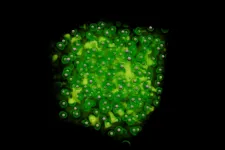
ELSE PRESS RELEASES FROM THIS DATE:
2021-01-28
With a powerful enough light, you can see things that people once thought would be impossible. Large-scale light source facilities generate that powerful light, and scientists use it to create more durable materials, build more efficient batteries and computers, and learn more about the natural world.
When it comes to building these massive facilities, space is money. If you can get higher-energy beams of light out of smaller devices, you can save millions on construction costs. Add to that the chance to significantly improve the capabilities of existing light sources, and you have the motivation behind a project that has brought scientists at three U.S. Department of Energy national laboratories together.
This team has just achieved an important milestone ...
2021-01-28
Attempts to identify the genetic causes of neuropsychiatric diseases such as post-traumatic stress disorder (PTSD) through large-scale genome-wide analyses have yielded thousands of potential links. The challenge is further complicated by the wide range of symptoms exhibited by those who have PTSD. For instance, does extreme arousal, anger, or irritation experienced by some have the same genetic basis as the tendency to re-experience traumatic events, another symptom of the disorder?
A new study led by researchers at Yale and the University of California-San Diego (UCSD) provides answers to some of these questions and uncovers intriguing genetic similarities between PTSD and other mental health disorders such as anxiety, bipolar disorder, and schizophrenia. ...
2021-01-28
Washington, DC - January 28, 2021 - Self swabs and caregiver swabs are effective at detecting multiple pathogens and are just as accurate as those taken by healthcare workers, according to a team of Australian researchers. The research appears in the Journal of Clinical Microbiology, a publication of the American Society for Microbiology.
"Across the range of pathogens and swab types, there was high agreement between results from self- or caregiver swabs and those performed by a healthcare worker, even when different sites were swabbed (e.g. nasopharyngeal vs. nasal)," said principal investigator Joshua Osowicki, BMedSci, MBBS, FRACP, a Pediatric Infectious Diseases physician in the Murdoch Children's Research Institute's ...
2021-01-28
Despite long-standing ideas about the importance of thumb evolution in tool use and development, questions remain about exactly when human-like manual dexterity and efficient thumb use arose--and which hominin species was the first to have this ability. Now, researchers who've analyzed the biomechanics and efficiency of the thumb across different fossil human species using virtual muscle modeling have new insight into when these abilities first arose and what they've meant for the development of more complex human culture. The findings, appearing January 28 in the journal Current Biology, suggest that a fundamental aspect of human thumb opposition first appeared approximately 2 million years ago and was not found ...
2021-01-28
What makes one person drive above the speed limit while another navigates steadily in the right lane? What motivates someone to leave a job with a steady paycheck to launch their own business while the other sticks to one employer for an entire career?
"People have different tendencies to engage in behavior that risks their health or that involve uncertainties about the future," says Gideon Nave, an assistant professor of marketing in Penn's Wharton School.
Yet explaining the origin of those tendencies, both in the genome and in the brain, has been challenging for researchers, partly because previous studies on ...
2021-01-28
ANN ARBOR, Michigan -- It was an unexpected discovery that started with an analysis of more than 1,000 genes. The question: why game-changing cancer immunotherapy treatments work for only a fraction of patients.
The analysis shone a light on one that popped up repeatedly in patients and mouse models that did not respond to immune checkpoint therapy: stanniocalcin-1, a glycoprotein whose role in both tumors and immunology is largely unknown.
By following the trail from this surprising thread, a University of Michigan Rogel Cancer team uncovered how stanniocalcin-1, or STC1, works inside the cell to block a cellular "eat-me" signal that typically triggers the immune system to produce T cells to fight the tumor. The findings, published in ...
2021-01-28
Scientists at the National Eye Institute (NEI) have developed a promising gene therapy strategy for a rare disease that causes severe vision loss in childhood. A form of Leber congenital amaurosis, the disease is caused by autosomal-dominant mutations in the CRX gene, which are challenging to treat with gene therapy. The scientists tested their approach using lab-made retinal tissues built from patient cells, called retinal organoids. This approach, which involved adding copies of the normal gene under its native control mechanism, partially restored CRX function. The study report appears today in Stem ...
2021-01-28
In early October 2019, when an unknown caller rang EPFL professor Johan Gaume's cell phone, he could hardly have imagined that he was about to confront one of the greatest mysteries in Soviet history. At the other end of the line, a journalist from The New York Times asked for his expert insight into a tragedy that had occurred 60 years earlier in Russia's northern Ural Mountains - one that has since come to be known as the Dyatlov Pass Incident. Gaume, head of EPFL's Snow and Avalanche Simulation Laboratory (SLAB) and visiting fellow at the WSL Institute for Snow and Avalanche Research SLF, had never heard ...
2021-01-28
Researchers at the University of Basel and Ruhr University Bochum have developed a source of single photons that can produce billions of these quantum particles per second. With its record-breaking efficiency, the photon source represents a new and powerful building-block for quantum technologies.
Quantum cryptography promises absolutely secure communications. A key component here are strings of single photons. Information can be stored in the quantum states of these light particles and transmitted over long distances. In the future, remote quantum processors will communicate with each other via single photons. And perhaps the processor itself will use photons as quantum bits for computing.
A basic prerequisite for such applications, however, is an efficient source ...
2021-01-28
Using X-ray tomography, a research team has observed the internal evolution of the materials inside solid-state lithium batteries as they were charged and discharged. Detailed three-dimensional information from the research could help improve the reliability and performance of the batteries, which use solid materials to replace the flammable liquid electrolytes in existing lithium-ion batteries.
The operando synchrotron X-ray computed microtomography imaging revealed how the dynamic changes of electrode materials at lithium/solid-electrolyte interfaces determine the behavior of solid-state batteries. The researchers found that battery operation caused voids to form ...
LAST 30 PRESS RELEASES:
[Press-News.org] Harnessing the power of AI to understand warm dense matter
CASUS researchers develop effective tool to describe exotic state of matter


